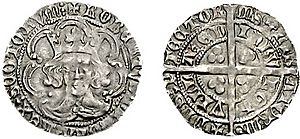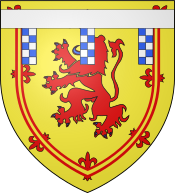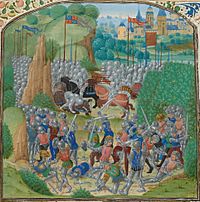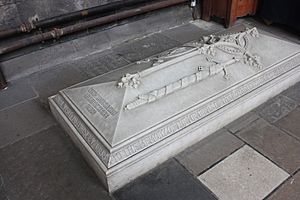Robert III of Scotland facts for kids
Quick facts for kids Robert III |
|
|---|---|

Groat of 1390 bearing a crowned facing effigy of Robert III on the obverse
|
|
| King of Scots | |
| Reign | 19 April 1390 – 4 April 1406 |
| Coronation | 14 August 1390 |
| Predecessor | Robert II |
| Successor | James I |
| Born | John Stewart c. 1337 |
| Died | 4 April 1406 (aged 68–69) Rothesay Castle, Isle of Bute, Scotland |
| Burial | Paisley Abbey |
| Spouse | |
| Issue more... |
|
| House | Stewart |
| Father | Robert II of Scotland |
| Mother | Elizabeth Mure |
|
Events
19 April, Robert II died at Dundonald Castle 14 August, Carrick crowned as Robert III but without power and Fife retains guardianship22 March, James's ship bound for France intercepted by the English and the prince began his eighteen-year captivity 4 April, the ailing King Robert died after learning of his son's fate |
|
Robert III (around 1337 – 4 April 1406), born John Stewart, was the King of Scots from 1390 until he died in 1406. Before becoming king, he was the High Steward of Scotland and held titles like Earl of Atholl and Earl of Carrick. He was the oldest son of King Robert II and Elizabeth Mure.
John joined his father and other powerful lords in a rebellion against his great-uncle David II in 1363. He married Anabella Drummond by 1367. In 1368, David made him Earl of Carrick. When his father became king in 1371, John became very important in the government.
In 1384, John (now called Carrick) was made the king's "lieutenant" or helper. This meant he ruled for his father, who was getting older. During his time, Scotland fought more with England. In 1388, the Scots won the Battle of Otterburn, but their leader, James, Earl of Douglas, was killed. Carrick was also badly hurt by a horse-kick. Because of this, his younger brother, Robert, Earl of Fife, took over as lieutenant in December 1388.
In 1390, Robert II died, and Carrick became King Robert III. However, he didn't have full power to rule. His brother Fife remained in charge until 1393. Later, in 1399, because the king was unwell, his son David became lieutenant. David was supervised by a group led by Fife, who was now called Duke of Albany.
King Robert III then stepped back from ruling. He couldn't stop a fight between Albany and his son David, which led to David's arrest and death in 1402. Albany was cleared of any blame and became lieutenant again. The king's only other son, James, was now the heir. In 1406, the 11-year-old James tried to escape to France but was captured by the English. Robert III died soon after hearing about his son's capture.
Contents
Early Life and Family
John Stewart was born around 1337. His father was Robert, Steward of Scotland, who was next in line to the throne. His mother was Elizabeth Mure. John's grandmother, Marjorie Bruce, was the daughter of Robert I, the first Bruce king.
John's parents married in 1336, but the Church didn't fully recognize it at first. They married again in 1349 after getting special permission from Pope Clement VI. This made sure John and his nine brothers and sisters were officially legitimate.
In the 1350s, John led a campaign to take back Scottish land from the English in Annandale. In 1363, he joined his father and other powerful lords in a rebellion against King David II. They were unhappy with the king's decisions and how he spent money. But they soon made peace with the king.
In 1367, John married Anabella Drummond. In 1368, King David II made John the Earl of Carrick. This showed that John was likely to be the next king. However, David II later ended his marriage, which meant he could marry again and possibly have a Bruce heir, putting the Stewart family's claim to the throne at risk.
King David II died unexpectedly in 1371. John's father, Robert, was crowned king at Scone Abbey on March 27, 1371. John was then called "Steward of Scotland." To make sure John would be the next king, the general council officially named him heir. In 1373, parliament passed laws to make sure the king's sons would inherit the crown in a clear order.
John and Annabella had a son named David on October 24, 1378. David would later become the Duke of Rothesay.
Becoming Guardian of Scotland
King Robert II wanted to make his family, the Stewarts, more powerful in Scotland. His son John (Carrick) became the most important Stewart lord in the south. His younger brother, Alexander, Earl of Buchan, became powerful in the north.
People started complaining that King Robert II wasn't ruling fairly. They also worried about Alexander, Earl of Buchan, who used wild fighters called "caterans." The king seemed unable to control his son. The king also wasn't doing enough to fight England.
Because of these problems, a meeting was held in November 1384. The decision was made to remove King Robert II from direct rule. Carrick was then appointed as the Guardian of Scotland. This meant he would rule the country.
Carrick quickly changed how the country was run. His friends and family, especially the Douglas family, gained a lot of power and money. In 1385, it was found that Carrick had taken a large sum of money from Edinburgh's customs without permission. His brother Fife, who was in charge of money, had trouble controlling Carrick's spending.
In April 1385, the council strongly criticized Buchan's behavior. They wanted Carrick to control his brother in the north. In July, a Scottish army, including French soldiers, attacked northern England. This led to a strong counter-attack by Richard II. But Carrick still didn't control Buchan. Many people were happy about fighting England again but worried about the lawlessness in the north.
Even though Carrick was made Guardian to stop Buchan, Buchan became even more powerful. By February 1387, he was made a "Justiciar" (a high judge) for the north. The war with England stopped for a while with truces. But in April 1388, Scotland decided to fight England again.
In August 1388, the Scots won the Battle of Otterburn in Northumberland. However, their leader, the Earl of Douglas, was killed. Douglas had no children, which led to arguments over his lands. Carrick supported one claim, while his brother Fife supported another. Fife's side won, and he gained a powerful new ally in the Douglas family.
At a council meeting in December 1388, the guardianship of Scotland was taken from Carrick and given to Fife. Carrick had recently been badly injured by a horse-kick. Fife promised to bring law and order to the north and control his younger brother Buchan. Buchan lost his position as Justiciar. King Robert II died in March 1390.
King Robert III's Reign
In May 1390, parliament allowed John to change his name to Robert. This was probably to connect him to Robert I and to distance himself from John Balliol, an earlier king who was seen as a failure. There was a four-month delay before Robert III was crowned. During this time, Fife and his allies worked to secure their power. Buchan also attacked Elgin Cathedral, perhaps as a protest against Fife.
Rothesay's Time in Charge
In 1392, Robert III gave his son David, now the Earl of Carrick, a large income. This helped David build his own group of supporters. In 1393, King Robert got his direct ruling power back, and David, who was now old enough, was to help his father.
The king showed his power in 1395-1396 when he stopped Carrick's unauthorized marriage to Elizabeth Dunbar. The king also handled foreign affairs, keeping peace with Richard II of England. He also increased the power of the "Red Douglas" Earl of Angus to balance Fife's "Black Douglas" allies.
To reduce fighting between clans, the king arranged a special combat between two clans in Perth in 1396. Carrick started acting more independently from his father, taking control of lands in the southwest.
People blamed the king for not controlling the wild areas in the west and north. In April 1398, a council in Perth criticized the king's rule. They gave his brother Robert (Albany) and his son David (Rothesay) the power to lead an army against Donald, Lord of the Isles.
In November 1398, important lords and church leaders met at Falkland Castle. This meeting led to a council in January 1399. The king was forced to give power to Rothesay for three years.
Rothesay and George Dunbar, Earl of March, had a big disagreement. Rothesay decided to marry Mary Douglas instead of Elizabeth Dunbar, as had been planned. March was furious and joined Henry IV of England. In 1401, Rothesay became more independent and started taking money without permission. He also challenged Albany's power.
When Rothesay's time in charge ended in 1402, he was arrested and put in Albany's Falkland Castle. He died there in March 1402. Albany and Douglas were suspected of being involved, but a council cleared them of all blame.
Albany's Time in Charge
After Rothesay's death, Albany became lieutenant again. Robert III was almost completely removed from political power. He stayed mostly on his lands in the west. By late 1404, Robert tried to regain some power. He helped Alexander Stewart, Buchan's son, in a dispute with Albany.
In December 1404, Robert III created a new special area of land for his only remaining son and heir, James. This was to stop these lands from falling into Albany's hands.
By October 1405, Robert III was back at Dundonald Castle. The king's health was failing. In the winter of 1405-1406, it was decided to send young Prince James to France to keep him safe from Albany.
In February 1406, James left St Andrews with some escorts. They traveled through dangerous Douglas lands. James had to escape to the Bass Rock after his escorts were attacked, and Sir David Fleming was killed. James stayed on the rock for over a month. Then, a ship going to France picked them up.
On March 22, 1406, English pirates captured the ship off Flamborough Head. They took James to King Henry IV of England. Robert III had moved to Rothesay Castle. After hearing about his son's capture, he died on April 4, 1406. He was buried in Paisley Abbey.
Family and Children
King Robert III married Anabella Drummond around 1366 or 1367. She was the daughter of Sir John Drummond. They had seven children:
- David Stewart, Duke of Rothesay (born 1378, died 1402). He was engaged to Elizabeth Dunbar but later married Lady Marjory Douglas.
- James I Stewart (born 1394, died 1437). He became King of Scots.
- Robert Stewart (died young).
- Margaret Stewart (died between 1450 and 1456). She married Archibald Douglas, 4th Earl of Douglas.
- Mary Stewart. She married four times: first to George Douglas, 1st Earl of Angus; second to Sir James Kennedy the Younger; third to Sir William Graham; and fourth to Sir William Edmonstone.
- Egidia Stewart (died unmarried).
- Elizabeth Stewart. She married James Douglas, 1st Lord Dalkeith.
Robert III also had at least two older children born outside of marriage:
- John Stewart of Ardgowan and Blackhall (born 1364, died 1412).
- James Stewart of Kilbride.
Fictional Stories
Robert III has appeared in historical novels. These include:
- The Fair Maid of Perth (1828) by Walter Scott. This book covers events from 1396 to 1402. It shows Scottish clan fights and other problems during Robert III's reign. Robert III, his son David, and his brother Robert (Albany) are important characters.
- The Lords of Misrule (1976) by Nigel Tranter. This book covers events from around 1388 to 1390. It shows the last years of Robert II of Scotland and Robert III becoming king. The old king is weak, and his children and other nobles fight for power.
- A Folly of Princes (1977) by Nigel Tranter. This book covers events from around 1390 to 1402. It shows Robert III as a weak king. His son David and brother Robert (Albany) compete for power in his court. This struggle gets the attention of Richard II and Henry IV, leading to England getting involved.
- The Captive Crown (1977) by Nigel Tranter. This book covers events from 1402 to 1411. It shows the last years of Robert III's reign and his son James I of Scotland being held captive by Henry IV. It also shows events back in Scotland.
Family Tree
Many powerful Scots during Robert III's time were his close relatives.
See also
 In Spanish: Roberto III de Escocia para niños
In Spanish: Roberto III de Escocia para niños
|
Robert III of Scotland
Born: c. 1337 Died: 4 April 1406 |
||
| Regnal titles | ||
|---|---|---|
| Preceded by Robert II |
King of Scots 19 April 1390 – 4 April 1406 |
Succeeded by James I |
| Peerage of Scotland | ||
| Preceded by Robert Stewart |
Earl of Atholl 1367 – 1390 |
Vacant
Title next held by
David Stewart |
| New title | Earl of Carrick 1368 – 5 March 1390 |
Succeeded by David Stewart |
| Court offices | ||
| Preceded by Robert Stewart |
High Steward of Scotland c. 1371–1390 |
Reverted to crown |
| New title | Guardian of Scotland November 1384–December 1388 |
Succeeded by Robert Stewart |






